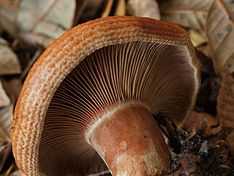Lactarius rubrilacteus
| Lactarius rubrilacteus | |
|---|---|
 | |
| Scientific classification | |
| Kingdom: | Fungi |
| Division: | Basidiomycota |
| Class: | Agaricomycetes |
| Order: | Russulales |
| Family: | Russulaceae |
| Genus: | Lactarius |
| Species: | L. rubrilacteus |
| Binomial name | |
| Lactarius rubrilacteus Hesler & A.H.Sm. | |
| Lactarius rubrilacteus | |
|---|---|
|
| |
| gills on hymenium | |
| cap is convex | |
| hymenium is decurrent | |
| stipe is bare | |
| spore print is cream | |
| ecology is mycorrhizal | |
| edibility: inedible | |
Lactarius rubrilacteus is a species of mushroom of the genus Lactarius.[1] It is also known as the bleeding milkcap, as is at least one other member of the genus, Lactarius deliciosus.[1]
Description
The mushroom can be either a bluish green or an orangy brown hue, with creamy white or yellow spores that are ellipsoid in shape.[2][3] The cap of the mushroom is convex and sometimes shield-shaped and 6–12 cm (2.4–4.7 in) across, reaching a height of 5–15 cm (2.0–5.9 in) tall. The cap also has quite an underfolded margin and a depressive disk.[2]
Lactarius rubrilacteus has many laticifers which appear as a white network across the surface of the mushroom.[3] When sliced or cut, the mushroom flesh will typically release a dark red to purple latex or milky substance.[1] The flesh itself will lose colour when damaged, and is usually granular or brittle to the touch.[2] The stem is quite thin, being only several centimetres in any dimension, and is of an average size and shape for a mushroom. The fungus itself exudes a slight odour that is faintly aromatic.[2] While it is not known if the mushroom would be edible, small taste tests reveal that the mushroom is mild to slightly bitter.[2]
Distribution and habitat
The mushroom is primarily found in parts of western North America, growing in forests and on the ground. The mushroom usually finds cover under conifer trees, mainly pines.[2] It is widely distributed in these areas between the months of June and October.[2]
Chemical reactivity
- Potassium hydroxide: When the mushroom comes in contact with potassium hydroxide, the most of the mushroom, including the mantle and ectomycorrhizae, loses its bluish hue and becomes a dull brown.[3]
- Melzer's Reagent: Hardly any visible reaction on any part of the mushroom occurs. This particular mushroom appears to have little reactivity to Melzer's Reagent.[3]
- Sulfovanillin: Most of the mushroom becomes a reddish brown color, but the oldest roots of the fungi stay unaltered by contact with sulfovanillin.[3]
See also
Notes
- ↑ 1.0 1.1 1.2 Robert Rich. "Lactarius rubrilacteus". Retrieved 18 April 2007.
- ↑ 2.0 2.1 2.2 2.3 2.4 2.5 2.6 "Lactarius rubrilacteus". RogersMushrooms.com. Retrieved 18 April 2007.
- ↑ 3.0 3.1 3.2 3.3 3.4 "Lactarius rubrilacteus Hesler & Smith". British Columbia Ectomycorrhizal Research Network. Retrieved 18 April 2007.